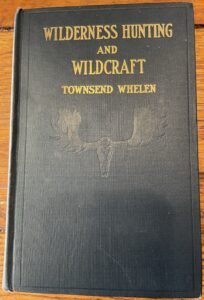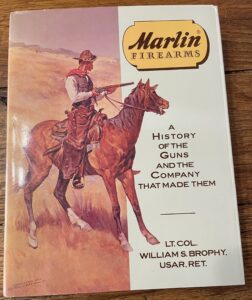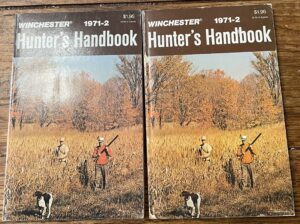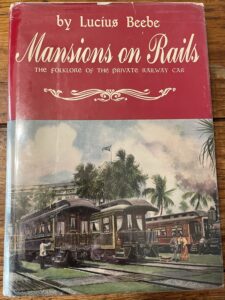I haven’t done one of these in a bit, and need to get back to it. And since it looks like the baseball season begins this week, I’m going to take the opportunity to throw a metaphorical change-up pitch with a train related book.
I would love to be able to document a book about guns on trains, but I don’t have a copy of Gerald Bull’s book. Yet.
After the jump…
Wilderness Hunting and Wildcraft, Townsend Whelen. Small-Arms Technical Publishing Company, Marshallton, Delaware, 1927. Riling 2026.
This is the second book Mr. Samworth published under the SATPCO imprint, and, according to Smith’s bibliography, this is the only impression of it. Smith is uncertain whether this was issued with a dust jacket: he says he was unable to find one with a jacket to photograph, he’s never seen a copy with a jacket, and he thinks it was probably issued without one. I choose to believe it was issued without jacket until proven wrong.
I’ve written before about Townsend Whelen, so I don’t feel the need to recap his biography here. This book was actually a revised and expanded edition of a small pamphlet, Big Game Hunting, which was published by Outers in 1923. It doesn’t just cover stalking various species of North American big game, but also goes into clothing, bedding, shelter, “finding one’s way”, and even physical preparation for hunting. I suspect a lot of Whelen’s wildcraft recommendations would still hold up today, though he points to Horace Kephart as the go-to guy for fieldcraft.
I’d call this pretty darn close to “new”. There’s maybe a small amount of wear to the top and bottom of the spine and the corners, but it is very small. I think this is a darn nice copy of a nearly 100 year old book. And sadly, I can’t find my invoices or communication with Callahan and Company (who I know I bought it from) so I can’t tell you how much I paid for it. I feel like I can say it wasn’t a really obscene amount. There’s one currently listed on ABEBooks for $100 in “very good” condition. There are also some reprints from other publishers in the $35 – $50 range.
Marlin Firearms: A History of the Guns and the Company That Made Them, Lt. Col. William S. Brophy (USAR – ret.). Stackpole Books, Harrisburg, PA, 1989.
This is a big thick square book, weighing in at about one ox stunning unit and covering the history of Marlin Firearms up through about 1989. As far as I can tell from the printer’s key and etc. this is a first edition first printing. (It has a $59.95 price tag, though, which makes me wonder: I found a discussion about this book on the Marlin forums, and one person says their copy was cover priced at $45: they paid $40 direct from the author at a Marlin Collector’s convention.) You can get this as a “new” book from Amazon for about $75.
I haven’t read the whole book yet, but it seems to be pretty comprehensive, covering all the Marlin firearms up to that point as well as Marlin’s peripherally firearms related and non-firearms related enterprises. As we all know, Bob, Marlin struggled in the 21st century and was bought by Remington in 2007. Remington, of course, had their own struggles, and sold Marlin to Ruger in 2020.
I found a short biography of LTC Brophy online. He was a highly regarded firearms expert, who was inducted into the Ordnance Hall of Fame, and served honorably in WWII, Korea, and as an advisor in Vietnam before the war. He also wrote several books, including a history of the 1903 Springfield (which I want now). The folks at Marlin were so impressed by this book, they made LTC Brophy the official company historian. He passed away in 1991.
I’d also call this one “like new”. I can’t find a single flaw with it, except maybe that it has a previous owner’s bookplate pasted in. It was bought as part of a stack of books at Crazy Lady Used Books & Emporium in Schertz when Mike the Musicologist and I paid them a visit. I’ll tell that story as a side note below.
Winchester Hunter’s Handbook 1971-72, Winchester Press, New York, 1971. Somehow I ended up with two copies of this.
I guess Winchester Press published these back in the pre-Internet days as a reference for hunters. There’s a breakdown of hunting seasons for various game by state, along with contact information for the local wildlife folks. There’s also a few short articles on things like “Sighting-In at Short Range” (Jack O’Connor) and “Precision Wildcats” (Warren Page).
I know one of these came from the Crazy Lady haul (because of the bookplate inside) and the other was purchased for $4.99 (plus tax) at Half-Price Books. They’re the kind of thing I like to collect, though I really don’t need more than one copy.
And finally…
Mansions on Rails: The Folklore of the Private Railway Car, Lucius Beebe. Howell-North, Berkeley, California, 1959.
What did people do before they had private planes? There were private yachts, but lots of destinations were not necessarily convenient for docking one’s ship. You could travel by private automobile, but not very far before the distance and lack of infrastructure took their toll. No, the beau monde back in the day traveled by private railroad car. As a matter of fact, some folks still do: Amtrak will let you hook your private car up to one of their trains (though there are rules and regulations) and there’s even an active group (The American Association of Private Railroad Car Owners) who can help you charter a private car, should you have the desire. I admit, this sounds kind of fun.
Some of the cars were intended for railroad officials, who used them as rolling offices. But many of them were elaborately outfitted beautiful affairs, representing the art and craftsmanship of the Gilded Age.
Lucius Beebe is an author I’ve been interested in for a while, but his books are hard to find these days. He was born into money. His father was a director of one of the railroads, which sparked a lifelong interest in that subject. He had the distinction of being expelled from both Harvard and Yale. He attempted to bomb “Corsair III” (J.P. Morgan’s personal yacht) from the air with toilet paper. He was a gourmet, a legendary sharp-dressed man, and a famous journalist of the time who wrote about “cafe society” for the New York Herald Tribune. Eventually he moved to Virginia City, Nevada with his (busines and life) partner Charles Clegg, and the two of them revived the old Territorial Enterprise.
And he and Clegg owned two private railway cars: the Gold Coast and The Virginia City. There’s a photo of the “drawing-observation salon” of the Virginia City tipped in to the front of the book.
Beebe dropped dead of a heart attack in 1966. Clegg killed himself in 1979.
This is a quite elaborately produced book. I wish there were more color photos of the inside of some of these cars, but I suspect that was a limitation of both the printing process and photography of the period when these cars were at their peak. Beebe found a list of the cars built by the Pullman Company between 1882 and 1930, and reproduces it as an appendix (with the names of the owners, and of the cars, where available). I haven’t read it, yet, but it seems like it will be a fun break from gun bookery.
There’s a bit of wear to the top front cover and the top and bottom of the spine, but I don’t think any of it is too bad. There’s also a small – perhaps 1″ long – blemish on the spine itself. I think “good”, but I’m not sure I’d go so far as “very good”.
$20 plus tax from Half-Price Books, which I think is very reasonable. It seems to me that railroad books, much like gun books, are targeted at a limited and specialized audience. And thus they command higher prices, especially on the secondary market.
Side note #1: So Mike the Musicologist and I went down to Crazy Lady over the holidays. We were a little delayed and got there just after 5:00 PM. Apple Maps said they closed at 5:30, so we figured we were in good shape. But the door was locked, so we called from the parking lot to check. The owners told us that Apple Maps and lots of other sites have them closing at 5:30, but they actually close at 5:00.
“No worries. We’ll just come back another time.”
“Do you know where we are?”
“Yes, we’re actually in the parking lot right now.”
“You are? (pause) Well, we’re going to be here a little while longer. Why don’t you just come on in? We’ll unlock the door for you.”
Second words out of my mouth when we got in (after “thank you”): “I promise, I’ll be done by 5:30.”
A bit later on:
“You don’t have to be in a hurry. We can stay.”
“No, I know you have a life, and I promised I’d be done by 5:30.”
(co-owner touches my shoulder and gives me one of those looks I’m used to getting, the “you poor deluded foolish person who has a sense of honor and keeps your promises in this day and age” looks)
Anyway, the two owners are really nice people. I encourage you to pay them a visit and buy stuff if you’re anywhere near Schertz. I picked up the Marlin and Winchester books, and a third book I’ll document later, for something around $25. I disremember the exact amount. The Marlin book had $14.99 penciled on the inside, so that was for sure a find worth driving to Schertz for. I do want to go back, but maybe closer to New Year’s this year. Give them some time to restock. Plus they still have their eBay store.
Side note #2: The Revolver Guy blog has been running a series of articles on the new S&W Lipsey’s “Ultimate Carry” J-frames. Part 1. Part 2. I need another J-frame like I need another hole in my head, but from what I’ve read (and Revolver Guy is no hack gunwriter: if a gun sucks, he and his writers will say so) I’m really excited about these guns. My local gun shop has them on order and I’m looking forward to handling one.
(Side note to the side note: my LGS does have one of the new S&W .44 Magnum lever guns. While I don’t really feel like I need a .44 Mag lever gun, and while the one they have is a synthetic stock stainless steel version rather than wood/blued, I have to say: based on my brief handling of it, I like it. The iron sights are excellent, to my aging eyes. They could really have something here.)
What brings this to mind is: part 2 has a brief discussion of the “tolerance stocking” problem.
S&W ran into this problem a little bit with the new J-frames, but not as bad as Remington did when they bought Marlin.
Ruger had to go in, re-measure all the parts, and update the plans before they could even start making guns. See footnote #24 in the linked article.





